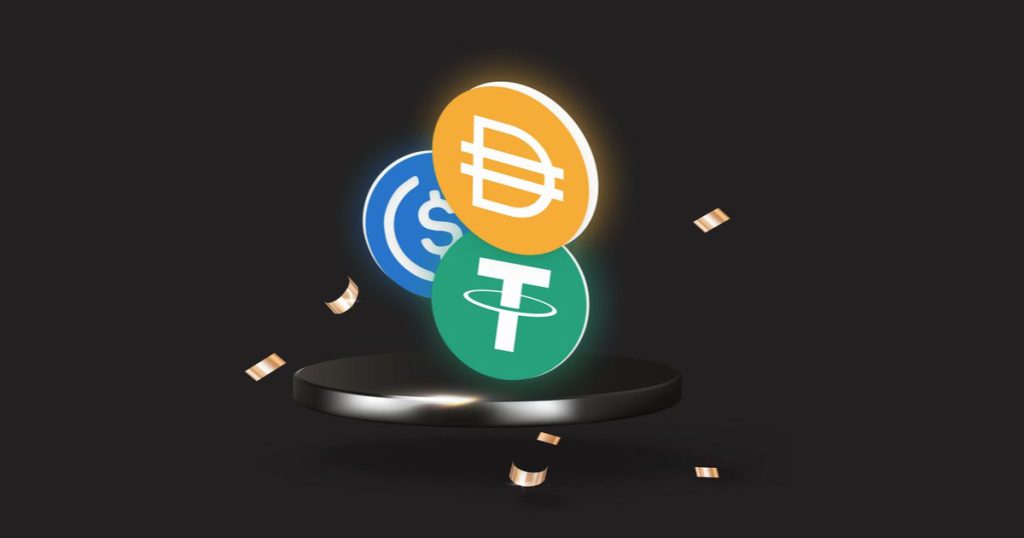Cryptocurrencies have long been characterised by volatility. As far back as 2013 – when Bitcoin rallied from US$550 to US$1,200, and back down to US$800 in a matter of weeks – it became apparent that there was a need for a more stable form of cryptocurrencies in the crypto space.
In traditional finance, they vary from commodities such as gold and silver, to fiat currencies like the US dollar. Investors use these assets to hedge and manage their risk exposure during times of uncertainty.
As with any investment, it is key to know what you are investing in – so far in our beginner’s guide to crypto, we’ve talked about the relationship between blockchain and cryptocurrencies, gone over a range of different blockchain applications such as NFTs and DeFi – from blue chips such as Bitcoin and Ethereum, to higher-risk meme coins like Shiba Inu, as well as explored why people are paying extraordinary amounts for NFTs.
In partnership with Luno’s education hub, Luno Discover, let’s now take a look at stablecoins – another vital segment of the crypto space.
What are stablecoins and how is it used?
A stablecoin is a cryptocurrency which, as the name suggests, is designed to maintain a relatively constant price. This is usually achieved by pegging the value of the coin to another asset class such as gold, or currency such as the US dollar.
Stablecoins are often used to interact with assets that are more prone to sharp price movements. Just like the name suggests, the stability of the stablecoins help to minimise volatility and provides more certainty to the value of the respective portfolio.
They are also used to facilitate trades on crypto exchanges – most often thought of like a “bridge” between fiat currency and cryptocurrency. Instead of buying cryptocurrency with fiat currency which requires more steps, time and/or costs, traders exchange fiat for a stablecoin and perform trades.
Especially in countries that experience politico-economic crises where local currencies lose extreme value, stablecoins are borderless, easily transferable and maintain value wherever you are in the world. Due to that, its application for payments and remittances is also another good use case.
How and what are stablecoins pegged to?
Stablecoins can be classified into one of four different categories:
1. Fiat-backed stablecoins
These are the most widely used variety of stablecoins, usually backed 1:1 by fiat currency.
For example, Tether (USDT) – which was one of the first stablecoins to be launched back in 2014 – is backed by the US dollar. All issued units of USDT are matched by an equivalent amount of US dollars stored in Tether’s reserves. This ensures that holders are able to redeem 1 USDT for US$1, and vice versa.
As of now, USDT has the highest market cap among all stablecoins and is the third largest cryptocurrency, behind Bitcoin and Ethereum.
USD Coin (USDC) is next in the rankings and is also fiat-backed. 80 per cent of the total stablecoin supply is shared between these two coins.

It’s worth noting that the reserves of fiat-backed stablecoins aren’t always made up of cash. They may also contain cash equivalents such as treasuries and bonds. These reserves are a good indicator of how secure the peg between a stablecoin and its underlying currency is.
As a rule of thumb, the more liquid the reserves, the more stable the peg. Imagine a situation of panic where thousands of investors want to convert their stablecoins back to fiat currency. If the stablecoin has all-cash reserves, it will have no problem fulfilling this demand and maintaining its peg.
However, say the reserves are partially made up of bonds which can only be converted to cash in a few months’ time. In this case, the reserves wouldn’t have enough liquidity to meet the sellers’ demands. This could cause the stablecoin to de-peg and lose its value.
For Singaporeans, XSGD is a choice of SGD-backed stablecoin. The issuing company, Xfers, is licensed by the Monetary Authority of Singapore (MAS) under the e-money issuance framework. As part of this framework, XSGD is required to be backed 1:1 by Singapore dollars stored in a local bank.
Xfers also publishes an attestation report – prepared by an independent accountant every month – detailing the number of XSGD tokens in circulation and the amount of Singapore Dollars held in the company’s reserves.
2. Commodity-backed stablecoins
There are also stablecoins backed by assets such as precious metals or oil, which share the same volatility as their underlying assets. They allow investors to gain access to real-world commodities without having to exit the crypto space.
PAX Gold (PAXG) is one of the most well-established stablecoins in this category, and ranks among the top 100 cryptocurrencies by market cap. Each unit of PAXG represents one troy ounce of a gold bar stored in a professional vault.

This is a convenient way to gain exposure to gold as the minimum investment required is as low as US$20, and there is no additional storage expenditure. Investors who’d be priced out from buying commodities in traditional markets can gain access to them using stablecoins.
PAXG can be redeemed for physical gold bars and US dollars, or traded in exchange for other cryptocurrencies. As a result, it provides investors with a lot more liquidity than other forms of gold investments.
Tether Gold (XAUT) is another popular gold-backed stablecoin, issued by the same company that launched USDT.
3. Crypto-backed stablecoins
These stablecoins have their value pegged to a fiat currency or commodity, but they are backed using crypto assets instead.
For example, Dai (DAI) tracks the US dollar and is only issued in exchange for crypto-based collateral.

In order to receive 10 DAI (worth US$10), a user might have to deposit over US$15 worth of Ethereum or another cryptocurrency. This is to safeguard against crypto volatility. Even if the value of the deposit were to fall up to 33 per cent, it would still be worth enough to account for the issued DAI.
If the value of the collateral fell even further below, it would get liquidated via an automated process. For example, a platform might require that the collateral’s value must always be 1.2 times the value of the loan. In this case, if the value of the user’s Ethereum deposit fell below US$12, it would get liquidated and they would lose the entire amount.
Despite these safeguards, crypto-backed stablecoins tend to be riskier than their fiat counterparts. When investing in such coins, it’s important to gauge the strength of their peg by checking how much excess collateral is held in the reserves, and which choice of cryptocurrencies are accepted as collateral.
4. Algorithmic stablecoins
Finally, there are algorithmic stablecoins, which also rely on other cryptocurrencies, but not for collateral.
The most well-known stablecoin in this category is one which no longer exists. In fact, its downfall was a major catalyst leading to the 2022 crypto downturn.
TerraUSD (UST) used to be the official stablecoin of the Terra blockchain. It maintained its peg to the US dollar through an algorithmic relationship with its sister cryptocurrency Terra (LUNA).
If the value of UST ever went above US$1 (due to high demand), LUNA holders could exchange US$1 worth of LUNA for 1 UST. Similarly, if the value of UST went below US$1 (due to lack of demand), UST holders could exchange 1 UST for US$1 worth of LUNA.
This arbitrage opportunity was meant to ensure that any deviations in UST’s price would correct themselves and its value would always return to US$1. However, in May this year, a different reality panned out.

Upon experiencing an extremely high volume of sell-offs, UST’s price began to decrease. Immediately, users began converting UST to LUNA to make use of the arbitrage opportunity.
Unfortunately, the algorithm couldn’t produce LUNA coins fast enough to restore UST’s peg. This caused further panic and accelerated the UST sell-off. At the same time, users began to also sell LUNA coins due to the rapidly increasing supply.
Both LUNA and UST lost almost all of their value in the span of a few days due to its interconnected nature, causing what they call a “death spiral”. This is not to say that all algorithmic stablecoins are doomed for failure, but they do indeed come with risks which might not be readily apparent.
Since they are not backed by any collateral, these stablecoins are only as strong as their underlying smart contracts. Any weaknesses in their algorithms can be exploited by users or inadvertently triggered by market volatility.
The Terra incident has surfaced the importance of having and practising common investment habits – knowing what you are investing in, only investing what you can lose, especially for assets with higher volatility like cryptocurrencies.
The future of stablecoins
After wiping out over US$17 billion in value, the LUNA/UST crash brought stablecoins to the attention of regulators around the world.

In June, Japan passed a key legislation under which only licensed companies will be allowed to issue stablecoins in the country. It’ll be necessary for the stablecoins to be linked to the Japanese Yen or another legal tender, and companies will also need to provide a guarantee of full redemption.
The UK is planning on regulating certain stablecoins under its payments framework. The aim is to make these cryptocurrencies safe and stable enough for consumer use.
In Singapore, the MAS believes that most stablecoins don’t meet the criteria to be classified as e-money. Even fiat-backed coins – although more stable than their algorithmic counterparts – record price fluctuations when trading on different exchanges.
Nevertheless, as seen with Xfers’ XSGD token, the MAS recognises the potential for stablecoins to serve as e-money upon meeting the designated criteria.
As countries come up with their own regulatory frameworks, it remains to be seen how stablecoins will play a role in shaping the future of cross-border transactions.
It is key to always know what you are investing in; it is one of the many ways to reduce your risk. To learn more about stablecoins, head over to one-stop crypto education hub Luno Discover, and subscribe to Luno’s Telegram channel and follow @luno_sg on Instagram for bite-sized crypto updates.
This article is part of a six-part series to a no-hype beginner’s guide to crypto. You can check out the other articles here:
– Part 1: Blockchain and cryptocurrencies
– Part 2: Types of coins and its risks
– Part 3: NFTs, DeFi and metaverse
– Part 5: How to DYOR
– Part 6: Free crypto tools
This article is written in collaboration with Luno.
This partnership between Vulcan Post and Luno is for educational purposes only. Luno Singapore has been awarded in-principle approval from the Monetary Authority of Singapore (MAS) under the Payment Services Act 2019. Cryptocurrency is a high-risk investment. The value of cryptocurrency can fluctuate significantly and you may lose the capital you invest. Before investing, we urge you to educate yourself about cryptocurrencies and to familiarise yourself with the risks involved, which are detailed in Luno’s Risk Warning.
Featured Image Credit: PYMNTS










